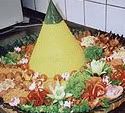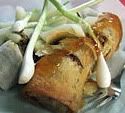
Rambutan
 The rambutan (pronounced /ræmˈbuːtən/, Nephelium lappaceum) is a medium-sized tropical tree in the family Sapindaceae, and the fruit of this tree. It is native to Indonesia and Southeast Asia, although its precise natural distribution is unknown. It is closely related to several other edible tropical fruits including the Lychee, Longan, and Mamoncillo. It is believed to be native to the Malay Archipelago.[1]. Rambutan in Indonesian, Filipino and Malay literally means hairy caused by the 'hair' that covers this fruit. In Panama, Costa Rica, and Nicaragua, it is known as mamón chino. There is a second species regularly for sale at Malay markets which is known as "wild" rambutan. It is a little smaller than the usual red variety and is colored yellow.
The rambutan (pronounced /ræmˈbuːtən/, Nephelium lappaceum) is a medium-sized tropical tree in the family Sapindaceae, and the fruit of this tree. It is native to Indonesia and Southeast Asia, although its precise natural distribution is unknown. It is closely related to several other edible tropical fruits including the Lychee, Longan, and Mamoncillo. It is believed to be native to the Malay Archipelago.[1]. Rambutan in Indonesian, Filipino and Malay literally means hairy caused by the 'hair' that covers this fruit. In Panama, Costa Rica, and Nicaragua, it is known as mamón chino. There is a second species regularly for sale at Malay markets which is known as "wild" rambutan. It is a little smaller than the usual red variety and is colored yellow.Description
It is an evergreen tree growing to a height of 10–20 m.
The leaves are alternate, 10–30 cm long, pinnate, with 3-11 leaflets, each leaflet 5–15 cm wide and 3-10 cm broad, with an entire margin.
The flowers are small, 2.5–5 mm, apetalous, discoidal, and borne in erect terminal panicles 15–30 cm wide.
Rambutan trees are either male (producing only staminate flowers and, hence, produce no fruit), female (producing flowers that are only functionally female), or hermaphroditic (producing flowers that are female with a small percentage of male flowers).
The fruit is a round to oval drupe 3–6 cm (rarely to 8 cm) tall and 3-4 cm broad, borne in a loose pendant cluster of 10-20 together. The leathery skin is reddish (rarely orange or yellow), and covered with fleshy pliable spines, hence the name rambutan, derived from the Malay word rambut which means hairs. The fruit flesh is translucent, whitish or very pale pink, with a sweet, mildly acidic flavour.
The single seed is glossy brown, 2–3 cm, with a white basal scar. The seed is soft and crunchy. They are mildly poisonous when raw, but may be cooked and eaten.
Production
It is a popular garden fruit tree and propagated commercially in small orchards. It is one of the best known fruits of southeast Asia and is also widely cultivated elsewhere in the tropics including Africa, Cambodia, the Caribbean islands, Central America, India, Indonesia, Malaysia, the Philippines, and Sri Lanka. Thailand is the largest producer from Surat Thani Province Thailand. Rambutan production is increasing in Australia and, in 1997, was one of the top three tropical fruits produced in Hawaii. It is also produced in Ecuador where it is known as "achotillo". Rambutan cultivation in Sri Lanka mainly composed with small home gardens. Malwana, a village located in valley of Kelani River holds high popularity for its rambutan orchards. The production comes to market in the months of May, June and July. In these months it is very common to observe seasonal traders around roads of colombo. In Sri Lankan context it is also possible to observe off season rambutan production in the months of januaery and February in areas like Bibile, Medagama and Monaragala.
The fruit are usually sold fresh, used in making jams and jellies, or canned. Evergreen rambutan trees with their abundant coloured fruit make beautiful landscape specimens.
Quality
Rambutan found in markets that is harvested as picked from their stems (pictured right, individual fruits in a pile) , is commonly ridden with bugs, prone to rot, and of relatively low viability per bunch sold, especially compared to other fruits.
The best quality rambutan is generally that which is harvested still attached to the branch (pictured above). This rambutan is less susceptible to rot, damage, and pests, and remains fresh for a much longer time than rambutan that has been picked from the branch.
Rambutan that is sold on a full branch is of much higher quality, maintains its true flavor, and is better fit for consumption than that which is sold as individually picked fruits. (source)



















0 comments:
Post a Comment